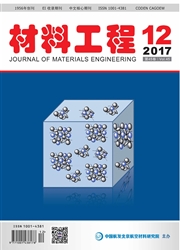

 中文摘要:
中文摘要:
采用表面机械研磨处理(SMAT)对纯铜进行表面改性,通过金属蒸汽真空弧离子注入技术在纳米表层注入Mo离子。利用光学显微镜(OM)、X射线衍射分析仪(XRD)和扫描电镜(SEM)观察SMAT处理效果,表面存在纳米层和变形层,通过原子力显微镜(AFM)表征纳米层的晶粒尺寸。结果表明:晶粒尺寸得到了显著的抑制,表面纳米层的晶粒在退火后长大到163nm,而注入了Mo离子的只长大到72nm。此外,SMAT并离子注入后材料表面的硬度仅达到SMAT试样的3.5倍,是纯Cu基体硬度的7倍左右。Mo离子的分散和由SMAT及离子注入引入晶体缺陷的反应促使了这些优化现象的产生。
 英文摘要:
英文摘要:
The surface of pure copper was modified using the surface mechanical attrition treatment(SMAT)method,and molybdenum ions were implanted in the nanosurface using a metal vapor vacuum arc(MEVVA).The results of the SMAT were observed by optical microscopy(OM),X-ray diffraction(XRD)and scanning electron microscopy(SEM).An obvious nanocrystalline layer and a deformation region exist on the surface.The size of the nanocrystalline layer was characterized using atomic force microscopy(AFM).The results indicate remarkable suppression on grain size,the nanocrystalline layer grows to 163 nm after annealing and reduces to only 72 nm due to the Mo ion implantation.In addition,the hardness of the topmost surface of the material is 3.5times that of the SMATed copper,which is about 7times of the value of the matrix.The above improvements most likely result from the dispersion of the Mo ions and the reactions of the crystal defects due to the SMAT and ion implantation.
 同期刊论文项目
同期刊论文项目
 同项目期刊论文
同项目期刊论文
 期刊信息
期刊信息
